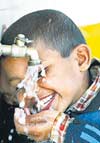| Safe drinking
water for the Sri Lankan population
“Our country has high levels
of rainfall and abundant water resources in certain
parts. However, with development and population growth,
there are increasing demands on our water resources.
These demands include basic water supply to people,
for farming purposes, for industrial growth, for power
generation and for sustaining the environment, so that
our natural systems can continue to support our development
in the future. This has led to water scarcity at times
in certain areas,”
About 72 percent of Sri Lanka’s
population has access to safe drinking water, Dinesh
Gunawardena, Minister of Urban Development and Water
Supply said last week,
Speaking at an international workshop
in Colombo on water issues, he said the population with
safe drinking water is served by piped water supply
- 28.4%, tube wells - 7.7%, protected dug wells - 34.1%
and others (including rainwater harvesting) -1.3%
 |
| 72 percent of Sri Lanka’s
population has access to safe drinking water |
In a keynote address, he said the workshop
is of particular significance in the context of the
Millennium Development Goals and of the goals set by
the World Summit on Sustainable Development in Johannesburg
and by the 4th World Water Forum in Mexico.
He said achieving basic water security,
harnessing the productive potential of water and limiting
its destructive impacts, has been a constant struggle
since the origins of human society. Sri Lanka has had
a long and proud history of over 2,500 years’
experience in the management and development of water
resources, and ancient hydraulic civilisations such
as Sri Lanka appear to have achieved the balance that
was required.
“Now, however, the situation
is somewhat different. The International Water Management
institute (IWMI), in its recently-released Comprehensive
Assessment of Water Management in Agriculture says that
one third of the world population face some form of
water insecurity. When our Presidents and Prime Ministers
met in the Millennium Summit, the goal was set to halve
the number of people with no clean water to drink. In
the Johannesburg conference’s concluding statement,
this promise was reaffirmed,” he said.
The minister said that efficient water
resources management requires that water be consumed
in an efficient manner.
Whilst universal access to water must
be ensured, this should not gainsay its efficient use
and must allow for the adequate distribution of water
amongst the different uses.
In view of the social importance and
sometimes-inadequate geographical distribution of the
resource, there should be an institutional framework
in place that promotes integrated water resource management.
He said poverty is widespread in the
rural sector in Sri Lanka, with 50% of the households
below poverty level in certain areas – in Hambantota
it is around 30%.
The main strategy being pursued to
develop the rural sector is to reduce poverty by implementing
integrated development programmes.
Agriculture and livestock should be
important sectors which have to be given priority in
our endeavours, as they can bring numerous social benefits,
including increased food security, better nutrition
and increased employment opportunities.
“Our country has high levels
of rainfall and abundant water resources in certain
parts. However, with development and population growth,
there are increasing demands on our water resources.
These demands include basic water
supply to people, for farming purposes, for industrial
growth, for power generation and for sustaining the
environment, so that our natural systems can continue
to support our development in the future. This has led
to water scarcity at times in certain areas,”
the minister noted.
|
